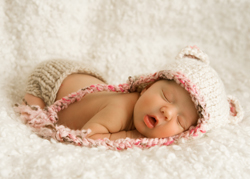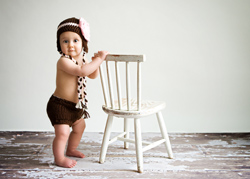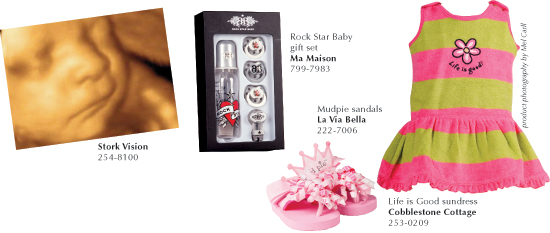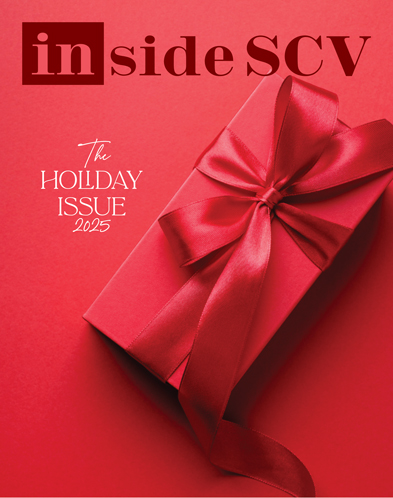FAMILY - BABY LOVE
Oh Baby!
June, 2010 - Issue #68
 photography by Laurie Sachs |
The American Academy of Pediatrics recommends breastfeeding throughout the first year of life, with the belief that breast milk is "the optimal form of nutrition for infant growth and development."
Beyond the vital bonding experience, health benefits provided through breastfeeding are encouraging. They include reduced illness and infection, and increased life expectancy.
The First Weeks Breastfeeding Support Group meets Thursdays from 9:30 a.m. to 11 a.m. and has grown from three postpartum mothers to close to 20 each week.
The weekly support group is open to all lactating mothers with newborns up to three months old. The support group meets in the ARU Dining Room in Henry Mayo Hospital's Pavilion. The cost is $10 per person.
The support group is one of several new services offered by the hospital's Lactation Services team. Services also available include a prenatal breastfeeding workshop, inpatient and outpatient bedside assistance and follow-up care, critical information on tools and products, as well as solutions to breastfeeding problems; 253-8238
Labor of Love Childbirth Education Program
Childbirth education classes take place Tuesdays from 6:30 p.m. to 9:30 p.m. in the Human Resources building. The classes are available to any expectant couple - not just patients of Henry Mayo Hospital. The cost per couple is $225 for the seven-class series or $35 per person per class. The next seven week session begins June 15.
A reduced offering of classes for busy parents or second-time parents are available on Saturdays from 9 a.m. to 5 p.m. The intensive Saturday classes cover four sessions and cost $150 per couple. Saturday classes take place May 22 and June 26.
Lisa Lavizani, RNC, clinical coordinator in the women's services unit, helps children prepare for their new responsibilities as a big brother or big sister in Henry Mayo's free Tyke Hike class. Siblings-to-be learn how to behave around a newborn, hold a baby properly, as well as other important safety tips. The children are also taken on a short tour of the women's services unit so they can see for themselves where Mommy will be having her baby. Tyke Hike is held the third Thursday of the month from 3 p.m. to 4:30 p.m.; 253-8607
Postpartum Passages Offers Support Group for Moms
To help moms ease into the transition that a newborn brings, Henry Mayo Newhall Memorial Hospital has developed a free postpartum support group. Moms are invited to share their experiences and concerns, or just listen, during discussions on the emotional adjustments experienced during pregnancy, birth and the first year postpartum. The support group is facilitated by trained specialists who understand the enormous changes and challenges that this transition can bring.
The free Postpartum Passages support group meets on Wednesdays at 12:30 p.m. in Henry Mayo's Human Resources Building. Henry Mayo has also created a resource line for new moms needing advice or someone to talk to about their concerns. The resource line is answered by trained specialists; 200-BABY
 photography by Laurie Sachs |
Santa Clarita Baby Network Holds Seminar for Expectant Parents
The Santa Clarita Baby Network is a unified group of quality businesses - including Laurie Sachs Photography, Renee the Midwife (Santa Clarita Birth & Women's Health Center) and Storks & Co. - that service new families in the Santa Clarita Valley. The Santa Clarita Baby Network offers quarterly seminars to expectant families. This quarter's seminar will be held at 6 p.m. at Gymboree of Valencia and will feature local pediatricians, as well as a question and answer session. Cost is $10 per person. Limited childcare available; www.scvbabynetwork.com
 |
Too Cute can Cost You
Bumper Pads and Baby Safety
It is understandable to think that soft things are safe for your baby - stuffed animals and soft toys, for example. But that's not always the case.
One of those soft things are bumper pads sold for cribs printed with cute designs with matching sheets. Research through records of the Consumer Product safety Commission by doctors at Washington University in St. Louis uncovered 27 deaths of infants from 1985 through 2005 due to crib bumper pads. This is probably a falsely low number since all such deaths are not reported.
Bumper pads caused death in three ways: by the baby's face wedged against the bumper; wedged between the bumper and the mattress; and a tie circling the child's neck.
Although the American Academy of Pediatrics has stated that bumper pads should be firm and not "pillow-like" this study actually found that the firm pads were more hazardous.
In the days when infants could get their heads trapped between the slats of a crib, bumper pads made sense. Since 1986, however, crib slats have been required to be no more than 2-3/8 inches apart. Since the danger of head entrapment is gone, there is no good reason for parents to cushion the sides of the crib.
Still, many parents are afraid that children will hit their heads on the rails or get their arms or legs stuck between the slats and break a bone. The truth is, it would be difficult for a small child to suffer a serious head injury bumping into the side of the crib and few children would have enough strength to break a bone if stuck through the slats.
If you sleep in the same room with your infant, the bumper pads interfere with your ability to see the infant. In addition, when they are able to pull themselves up, children can use the pads as a stepping stone to be high enough to crawl over the rail.
Although bumper pads are cute, I think the safer decision is to leave them off the crib.
Dr. Loraine M. Stern, M.D. is a member of Valencia Pediatric Associates (294-2229) and clinical professor of pediatrics UCLA.
|
||||||||||||||||||||||||||||




